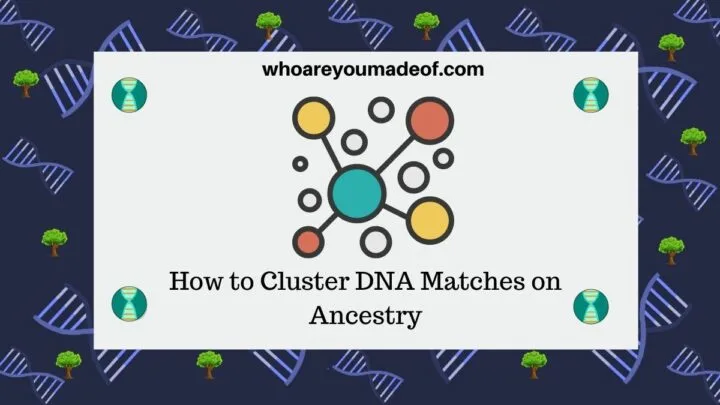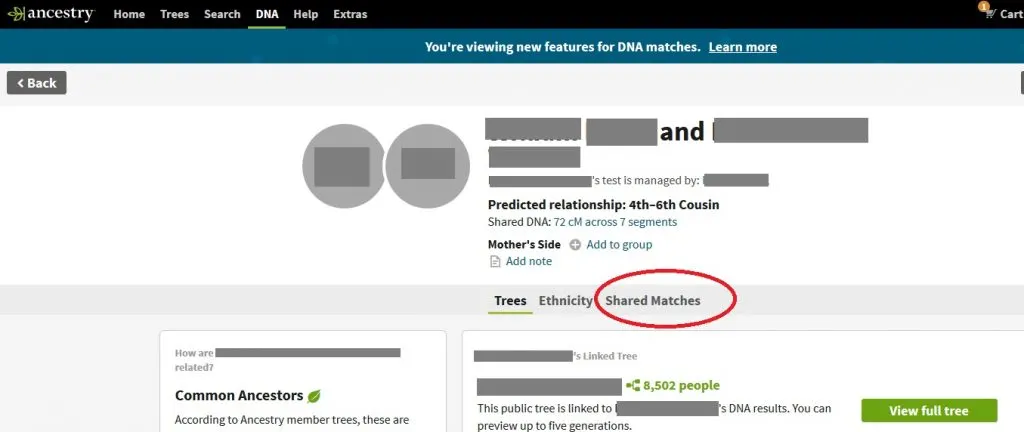Have you wondered whether it is possible to cluster your DNA matches on Ancestry? In this post, learn how to easily group your matches into clusters to identify common ancestors.
Most of us have thousands, if not tens of thousands of people on our Ancestry DNA match list. The sheer number of DNA matches can make even the most experienced family tree researcher feel a bit intimidated.

How should one approach understanding who these people on our DNA match list are, and how they might be related? We certainly could approach the list one-by-one, which I actually do recommend you do with your top twenty matches, but there are good reasons to organize your matches into larger groups for analysis.
You might be under the impression that you can’t actually do clustering on Ancestry because there is no chromosome browser. While it’s true that we don’t have access to detailed chromosome information on Ancestry DNA, we can still manually cluster our matches.
With the addition of the ability to group our DNA matches By Parent on Ancestry, this process is made even more effective and easier than even.
Why cluster your Ancestry DNA matches?
Sorting your Ancestry DNA matches into clusters of people who might be related to each other in the same way that you are is a great way to analyze your DNA match list. Clustering is a useful strategy that can help you identify common ancestors shared between groups of matches.
You can use the cluster method for researching your DNA matches to determine unknown ancestors, or to determine how you are related to other matches. While not foolproof, it is a very robust and methodical way to make sense of your DNA match list.
This strategy is similar to the Leeds Method, which follows a similar process yet uses a spreadsheet to keep track of the matches.
How do you group or cluster DNA matches on Ancestry?
As I mentioned above, to cluster your Ancestry DNA matches is simply to sort your matches into groups of people who are possible related to each other in the same way. Then, you will research the family trees, when available, of each DNA match in each cluster in order to determine a shared ancestor.
Steps to take to cluster your Ancestry DNA matches:
- Beginning with a second or third cousin match, identify all shared DNA matches
- Assign all of those DNA matches to the same custom group (instructions below)
- Find all DNA matches shared with all members of the custom group and assign those matches to the same group
- Repeat process with another second or third cousin DNA match who is unrelated to the first match
- Once you have assigned about 30-50 DNA matches to clusters (or more, if desired) you can begin the process of researching your matches and identifying likely shared ancestors within the cluster
Below, you will see further detail and instructions for each step in the process.
Note: If you have already created groups on Ancestry DNA, you can still use this process. You will just need to choose different colors and names for your clusters that you have not already used before.
Shared Matches on Ancestry can help you form clusters
You can identify DNA matches who are likely connected to each other through the same common ancestor using the Shared Matches feature.
To access the Shared Matches feature, you must first choose a DNA match. For the purpose of clustering your DNA matches, you should begin with second and third cousins.
If you click on one of your cousins from your DNA match list, you will notice that you can see your shared matches, or people who you share in common as DNA matches, right on the Ancestry Matches Compare page.

The Shared Matches feature will show you people who are related to you and your DNA match. For clustering, especially where we don’t have access to detailed chromosome data, such as the exact location and size of shared DNA segments, we work off the assumption that the match and the shared matches share the same common ancestor.
It is possible to share a match in common with a DNA match and be related to both of those people in different ways. For example, if you share Sally and Doug as matches in common with Jane, you might eventually discover that you are connected to Sally and Jane through one of your paternal great-grandparents, yet share a common ancestor with Doug on your mother’s side of the family.
However, for the sake of simplicity, especially when we are first getting started, we just assume that all shared matches are connected through the same ancestor. Once you begin to research your clustered groups of matches, you can determine if you need to eliminate some of the matches from the group.
Assign your DNA match and shared matches a custom group
The quickest and easiest way to cluster your Ancestry DNA matches is to assign them into groups based on colors. You will assign the group a custom color and name.
To access this feature directly from the first clustered DNA match’s profile page (or the Matches Compare page, as known on the Ancestry site), and click where it says “Add to Group” under where it lists the amount of shared DNA (shown below):

You will be prompted to choose a color and enter a group name. Once you have done this, click “Save” to create your new group, which is also your first cluster.
The name of your group, or cluster, can be a number that you have determined, the name of line of your family tree that you think you match on, or even the name of a town or region where most of the matches seem to have ancestry. The most important thing is to choose a name that you will be able to connect with this group of matches, since you will likely end up having several clusters once you are finished with this process.
Find shared matches of the shared matches and add them to the cluster
Now, you should access each DNA match that is in your first cluster and view all of the matches that you share with them. These matches should also be added to the same cluster.
Tip: Don’t skip adding cousins to the cluster if you already know how you are related. This might help you identify how the other matches in the cluster are related.
Once all of the shared matches are added to the cluster, you can move on to the next 2nd or 3rd cousin on your match list that is not already in a cluster
Ancestry DNA cluster analysis for genealogy
You can use the cluster method for Ancestry DNA matches to identify an unknown ancestor shared by the group. Some people have even been known to triangulate clustered groups of matches to identify their biological origins, so it certainly is a powerful tool.
To perform the analysis of your Ancestry DNA clusters and get useful information from your efforts, you must identify which of the DNA matches in a cluster has a family tree attached to their DNA results. If few of the matches in your cluster have family trees (there are lots of reasons for this!), you could also consider contacting your DNA match to see how much they know about their family tree and whether they would like to share information.
If you have a few matches in the cluster that have small trees, you might be able to build a “quick and dirty” family tree for your matches to complete their family tree a few more generations back. This is a great way to find common ancestors.
Once you have identified a common ancestor for a few members of your clustered group of Ancestry DNA matches, you might discover that you, too, are descended from that ancestor. You could also discover that you need to split your cluster into two groups, if you find evidence that multiple members are related to you through different lines.
Of course, you could also consider uploading or testing with other companies, such as 23andMe or MyHeritage, to find new matches to add to your clusters. And, best of all, MyHeritage has an AutoCluster tool you can use to help you in your efforts, too.
Conclusion
I hope that this post has helped you understand how you can cluster your Ancestry DNA matches, and how this process might help you discover new things about your family tree.
If you have any questions about something that you read here, or if you would like to share how clustering your DNA matches (on any site!) has helped you, I would love to hear from you in the discussion below.
Thanks for stopping by!


Laura
Monday 2nd of October 2023
What do you do when you have a cluster of folks that you cannot figure out where they fit in? I have 2 groups or matches that are from 25-53 cM that match each other and some of my 3d cousins but I have no idea where they fit into my tree even creating trees for them past where they have stopped. I do have a brick wall with my 3d great grandmother's parents so I am thinking it is from there. But that area that they are from could have endogamy. One cluster has descendants of a specific family and one cluster just seems to have colonial NY first immigrants, but no specified area or family. With both I am just stuck.